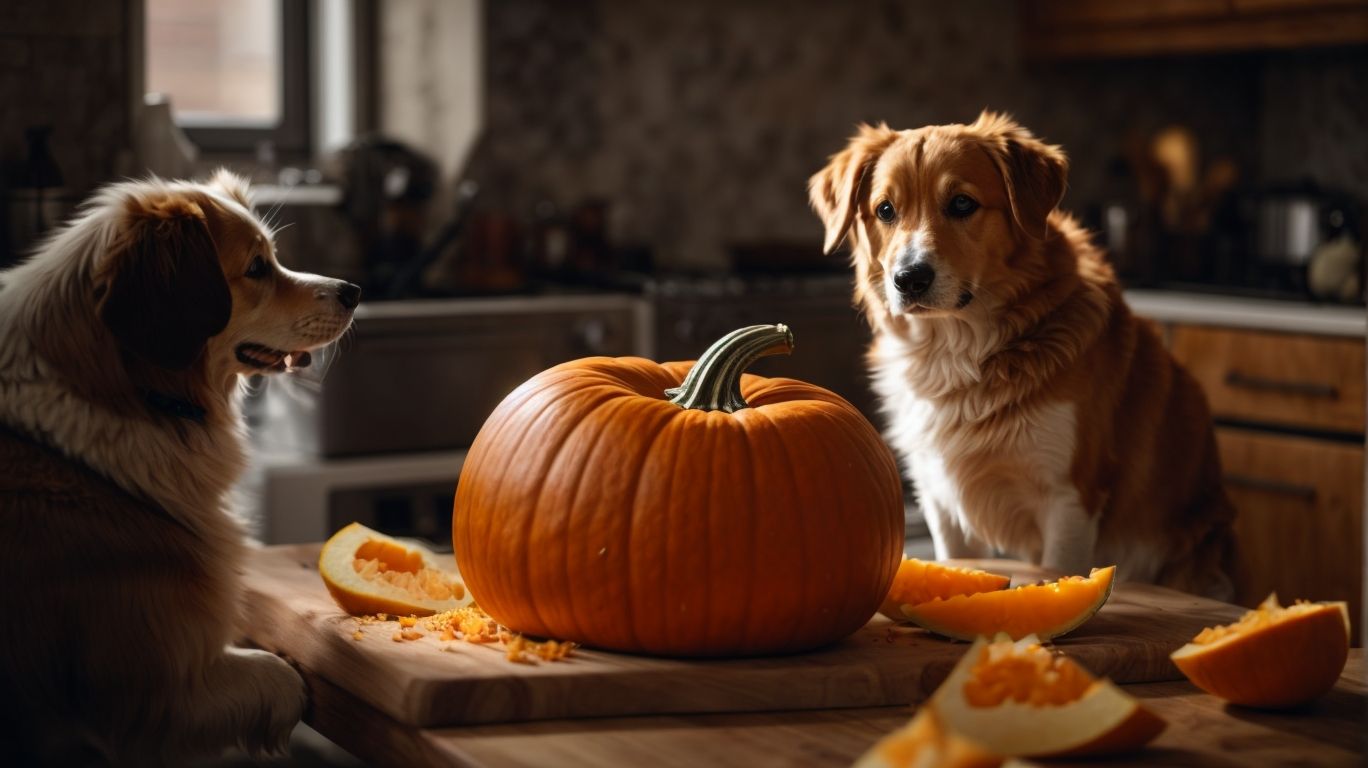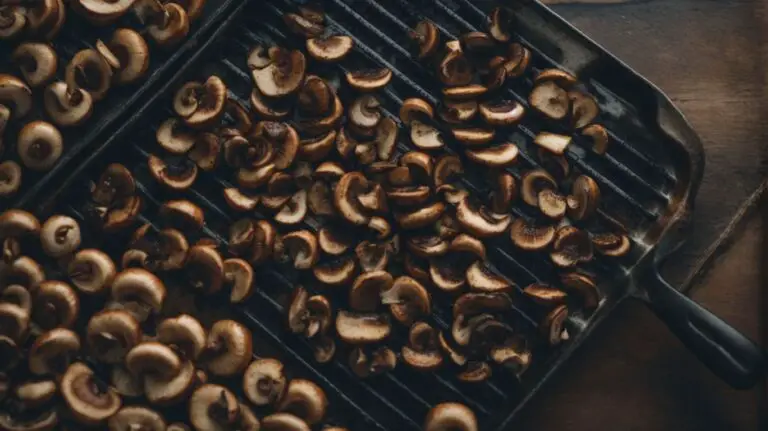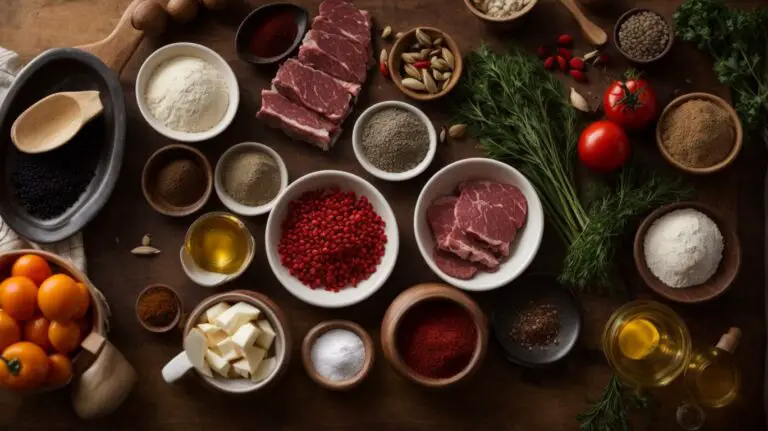How to Cook Pumpkin for Dogs?
Are you looking for a natural and nutritious treat to add to your dog’s diet? Pumpkin might just be the answer!
We explore the many benefits of feeding pumpkin to dogs, including its nutritional and digestive advantages.
Discover how to choose the right pumpkin for your furry friend and get tips on preparing and cooking pumpkin for dogs.
Learn how you can easily incorporate this healthy ingredient into your dog’s meals and treats!
Key Takeaways:
Why Feed Pumpkin to Dogs?
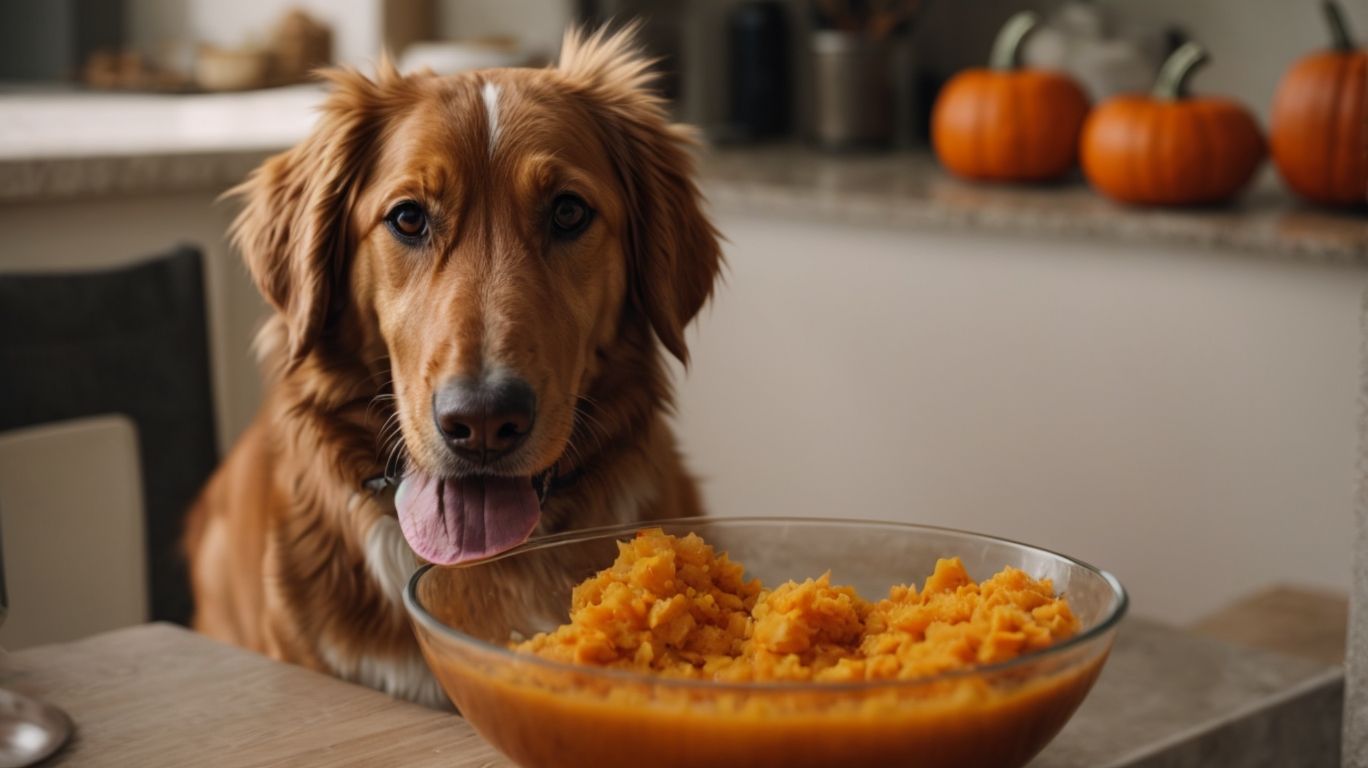
Credits: Poormet.Com – Steven Wright
Feeding pumpkin to dogs is a beneficial addition to their diet, offering a variety of nutrients and aiding in weight loss management.
Rich in fiber, vitamins A, C, and E, as well as beta-carotene, pumpkin plays a crucial role in supporting a dog’s digestive health, immune system, and vision. The fiber content helps regulate bowel movements, preventing constipation and diarrhea. The low-calorie nature of pumpkin makes it an excellent option for dogs struggling with weight issues. Incorporating pumpkin into their meals can also help alleviate digestive upset and improve satiety. Its natural sweetness makes it appealing to most dogs, making it an easy addition to their daily routine.
What Are the Nutritional Benefits of Pumpkin for Dogs?
The nutritional benefits of pumpkin for dogs are vast, providing essential nutrients, aiding in weight management, and offering a low-calorie addition to their diet.
One key nutrient found in pumpkin that is beneficial for dogs is fiber, which helps in promoting healthy digestion and regulating bowel movements. Pumpkins are rich in essential vitamins such as A, C, and E, which support a dog’s overall immune system, skin, and coat health. Pumpkins also contain important minerals like potassium and iron, contributing to a balanced diet and proper muscular function in dogs. Combining all these nutrients, pumpkin can play a vital role in enhancing a dog’s health, aiding in weight control, and improving their gastrointestinal health.
What Are the Digestive Benefits of Pumpkin for Dogs?
Pumpkin offers digestive benefits for dogs due to its fiber content, aiding in digestion, promoting healthy bowel movements, and providing essential moisture to their diet.
The fiber in pumpkin acts as a prebiotic, promoting the growth of beneficial bacteria in the gut, which enhances the overall health of the digestive system.
- The texture of pumpkin is soft and easy to digest, making it gentle on your furry friend’s stomach.
- Its high moisture content helps prevent dehydration and supports hydration, crucial for proper digestion.
The seeds of the pumpkin are also beneficial for dogs, as they are a good source of healthy fats and fiber, aiding in regulating cholesterol levels and promoting satiety, contributing to a well-rounded canine diet.
How to Choose the Right Pumpkin for Your Dog?
Selecting the right pumpkin for your dog involves choosing a fresh, organic pumpkin from a reputable store, ensuring it is free of mold or damage.
When searching for the perfect pumpkin for your furry companion, opt for those with a firm skin and rich color, as these are signs of freshness and nutritional value. Avoid pumpkins with soft spots, cuts, or bruises. Pumpkins labeled as organic are preferable as they are grown without harmful chemicals.
Once you’ve found the ideal pumpkin, handle it carefully to preserve its quality. After removing the seeds, store the pumpkin in a cool, dry place, like a pantry or refrigerator, to prevent spoilage and maintain its freshness.
Preparing Pumpkin for Dogs
Preparing pumpkin for your dog involves washing, cutting, and removing any seeds or waste before cooking or serving it to your furry friend.
After washing the pumpkin thoroughly, make sure to dry it before proceeding to cut it into suitable portions. Removing seeds is crucial to prevent any digestive issues for your pet. You can use a spoon or a scoop to easily take out the seeds.
To minimize waste, consider using the removed seeds for roasting as a healthy snack for yourself, or even for your dog if they enjoy it. When storing pumpkin, wrap the portions tightly in plastic wrap or place them in airtight containers before putting them in the freezer.
When preparing the pumpkin for your dog, consider steaming or baking it without any added seasonings to maintain its natural nutrients and flavor.
Fresh Pumpkin
Fresh pumpkin is a great choice for dogs, offering a firm texture and natural sweetness that can be enhanced through baking or steaming.
When preparing fresh pumpkin for your canine companion, start by selecting a ripe, firm pumpkin to ensure the best flavor and nutrients.
- Texture: Dogs often enjoy the crunchy texture of baked pumpkin, which can also help clean their teeth naturally.
- Flavor: The natural sweetness of fresh pumpkin adds a delicious element to your dog’s meal, making it more enticing.
- Nutritional Value: Pumpkins are rich in fiber, vitamins, and minerals, providing a healthy boost to your dog’s diet.
To bake or steam fresh pumpkin, begin by washing the exterior thoroughly, then cut it into manageable pieces, removing the seeds and stringy pulp.
For baking, preheat your oven to 350°F (175°C) and place the pumpkin pieces on a baking tray, then cook until tender, typically for about 45 minutes to an hour.
Canned Pumpkin
Canned pumpkin can be a convenient option for dog owners, offering a quick and easy way to incorporate this nutritious ingredient into their pet’s diet.
Regarding storing canned pumpkin, make sure to keep it in a cool, dry place away from direct sunlight to maintain its freshness. For dog food recipes, canned pumpkin can be mixed with a variety of ingredients such as lean meats, cooked grains, or even plain yogurt to create a balanced and tasty meal for your furry friend.
Its availability year-round makes it a reliable pantry staple for pet owners looking to add nutritional value to their dog’s diet without the hassle of preparing fresh pumpkin. The versatility of canned pumpkin allows for creativity in recipes, whether you’re making homemade dog treats, meals or incorporating it into specialized diets for dogs with certain health concerns.
How to Cook Pumpkin for Dogs?
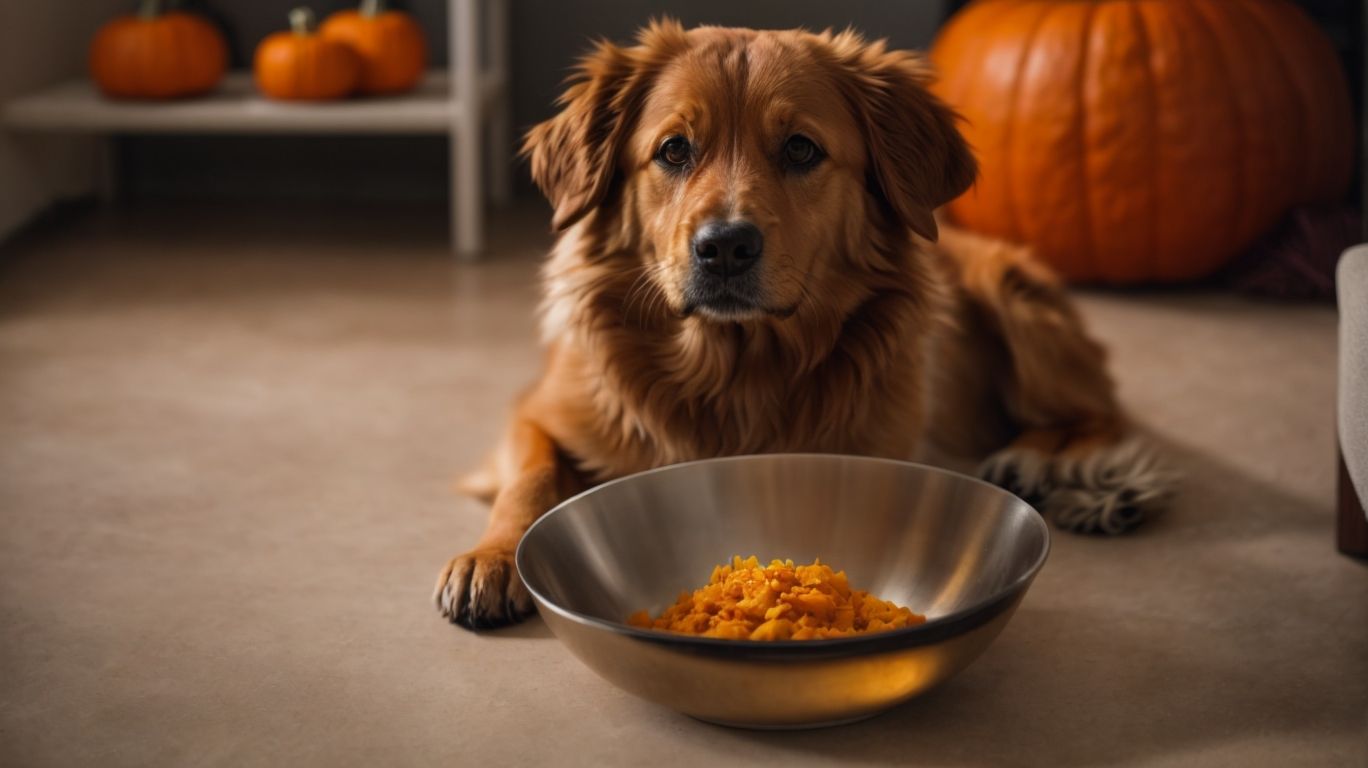
Credits: Poormet.Com – Philip Miller
Cooking pumpkin for dogs can be done through baking, steaming, or boiling methods, each offering a unique flavor and texture for your furry companion.
If you opt for baking, preheat your oven to 375°F (190°C). Cut the pumpkin into manageable wedges, removing the seeds and stringy bits. Place the pumpkin wedges on a baking sheet lined with parchment paper and roast for about 45-60 minutes or until the flesh is tender. This method locks in the natural sweetness of the pumpkin while adding a slight caramelization to enhance the taste.
Baked Pumpkin
Baked pumpkin is a delightful treat for dogs, offering a savory aroma and tender texture that can elevate their mealtime experience.
When baking pumpkin for your furry friends, it’s crucial to start by selecting a fresh, ripe pumpkin. The oven should be preheated to 350°F for ideal roasting. Slice the pumpkin and remove the seeds, then cut it into chunks or cubes to facilitate even cooking. Sprinkle with a touch of cinnamon for added flavor and aroma.
Place the pumpkin pieces on a baking tray lined with parchment paper. Roast them for approximately 30-40 minutes until they turn soft and slightly caramelized. The kitchen will fill with the delightful scent of roasted pumpkin, making tails wag in anticipation.
Steamed Pumpkin
Steamed pumpkin offers a moist and tender texture that dogs find appealing, making it a nutritious and satisfying addition to their diet.
When steaming pumpkin for your furry friend, you enhance the retention of moisture, ensuring that the dish remains juicy and palatable. This cooking method helps preserve essential nutrients that might otherwise be lost through boiling or baking. By steaming pumpkins instead, you maintain their natural flavors, enticing your pet with the authentic taste of this healthful vegetable. To steam pumpkins efficiently, simply cut them into manageable slices, place in a steamer over boiling water, and steam until fork-tender.
Boiled Pumpkin
Boiled pumpkin can be a simple and quick option for dog owners, retaining essential nutrients and minimizing waste during the cooking process.
When boiling pumpkin for your furry friend, start by choosing a fresh, ripe pumpkin and washing it thoroughly to remove any dirt or debris. You can peel the pumpkin if desired, but leaving the skin on can add extra fiber and nutrients to your dog’s diet. Cut the pumpkin into small, bite-sized pieces to help it cook evenly and speed up the boiling process.
- For the perfect water-to-pumpkin ratio, aim for about 1-2 cups of water for every cup of diced pumpkin.
- Bring the water to a boil in a pot, then add the pumpkin pieces and reduce the heat to a simmer.
- Let the pumpkin cook for around 15-20 minutes, or until it is tender but not mushy.
How to Incorporate Pumpkin into Your Dog’s Diet?

Credits: Poormet.Com – Mark Walker
Incorporating pumpkin into your dog’s diet can be achieved through homemade treats, pumpkin puree, or as an ingredient in their meals, offering a versatile and nutritious addition to their food.
-
Pumpkin is not only a great source of fiber, which aids in digestion for your furry friend, but it also provides essential vitamins and minerals like vitamin A and potassium.
-
For homemade treats, consider baking pumpkin dog biscuits using a mix of whole wheat flour and pumpkin puree for a tasty and healthy snack option.
-
You can also blend pumpkin puree with plain yogurt and a dash of cinnamon for a delicious and creamy treat that can be frozen into ice cube molds for a cooling summertime snack.
Pumpkin Treats
Pumpkin treats are a delightful indulgence for dogs, offering a blend of flavors and textures that can be customized through baking or freezing methods.
By combining pumpkin puree with ingredients like peanut butter, oats, and eggs, you can create a nutritious and tasty snack for your furry friend.
Experimenting with cinnamon or honey can elevate the flavors while adding a touch of sweetness to the treats.
When baking, ensure a consistent dough thickness to achieve an even bake, or opt for freezing for a refreshing treat during hot days.
Pumpkin Puree
Pumpkin puree serves as a versatile ingredient for enhancing your dog’s meals, providing essential nutrients, and adding a rich texture to their food.
Regarding the nutritional benefits, pumpkin puree is packed with essential vitamins and minerals such as Vitamin A, Vitamin C, and fiber, which can aid in digestion and overall well-being of your furry friend.
Its natural sweetness is appealing to most dogs, making it an excellent way to encourage them to eat their meals. The smooth texture of pumpkin puree can help in blending it seamlessly with other ingredients, ensuring a balanced and delicious meal.
Whether mixed into their regular kibble, used as a topper, or baked into homemade treats, pumpkin puree can be easily incorporated into various dog food recipes.
How Much Pumpkin Should You Feed Your Dog?
Determining the appropriate amount of pumpkin to feed your dog depends on factors such as their size, weight, and dietary requirements, ensuring a balanced and healthy intake.
When determining portion sizes of pumpkin for dogs, it is vital to consider their calorie needs. Smaller breeds typically require around one to four tablespoons per serving, while larger breeds may need up to half a cup. Portion control is crucial to prevent overfeeding which can lead to digestive issues. Cooked pumpkin is an excellent option as it retains its nutritional value – avoiding additives like sugar or salt. Remember, integrating pumpkin into your dog’s diet should be part of a well-rounded plan to ensure they receive proper nutrients.
Precautions When Feeding Pumpkin to Dogs
When feeding pumpkin to dogs, it is essential to monitor for potential allergies, avoid seasoning or additives, and consult with a veterinarian for guidance on incorporating it into their diet.
Introducing a new food item like pumpkin to your furry friend’s diet can be beneficial, but ensuring a smooth transition requires a few key steps.
- Allergy Monitoring: Keep a close eye on any signs of allergic reactions such as itching, swelling, or gastrointestinal upset after introducing pumpkin.
- Avoid Seasonings and Additives: Plain, cooked pumpkin is the best option as added seasonings or spices can upset your dog’s stomach.
- Consulting a Veterinarian: Before making any dietary changes, it’s crucial to seek professional advice from a vet to discuss your dog’s individual dietary needs and any potential sensitivities.
Consult with a Vet
Consulting with a veterinarian before introducing pumpkin to your dog’s diet is crucial to ensure their nutritional needs are met and any potential allergy risks are minimized.
- Professional advice: A qualified vet can provide tailored recommendations based on your dog’s specific health conditions, age, and activity levels.
- Health assessments: Vets can conduct thorough health evaluations to determine if any underlying issues may impact dietary changes.
- Allergy evaluations: Identifying potential allergies early can prevent serious reactions and ensure a safe transition to new foods.
Remember to observe your dog’s behavior closely after introducing pumpkin and be vigilant for any signs of digestive upset or adverse reactions.
Watch for Allergies
Monitoring your dog for potential allergies after introducing pumpkin is essential to identify any adverse reactions and ensure the ingredient is well-tolerated.
Recognizing the signs of allergic reactions in dogs can help prevent more severe health issues. Symptoms such as itching, sneezing, coughing, or gastrointestinal disturbances may point to an intolerance to certain ingredients like pumpkin. It is crucial to carefully observe your furry companion for any changes in behavior or physical appearance after pumpkin consumption.
When keeping an eye out for allergies, it is recommended to stick to plain pumpkin without seasonings or additives. Spices like nutmeg or cinnamon can trigger sensitivities in dogs, worsening allergic responses. Opting for a simple and balanced diet allows you to pinpoint potential allergens more effectively.
Avoid Seasoning and Additives
When feeding pumpkin to dogs, it is advisable to avoid seasonings and additives to maintain the ingredient’s natural flavors and prevent unnecessary waste.
Seasonings, flavor enhancers, and additives commonly found in human food can wreak havoc on a dog’s sensitive digestive system. Dogs have much simpler dietary needs compared to humans, and their systems do not always tolerate the same ingredients. By keeping pumpkin pure, you ensure that your furry friend receives all the nutritional benefits without the potential risks associated with added ingredients. This approach not only protects their digestive health but also optimizes the natural goodness of the ingredient for your dog’s overall well-being.
Conclusion
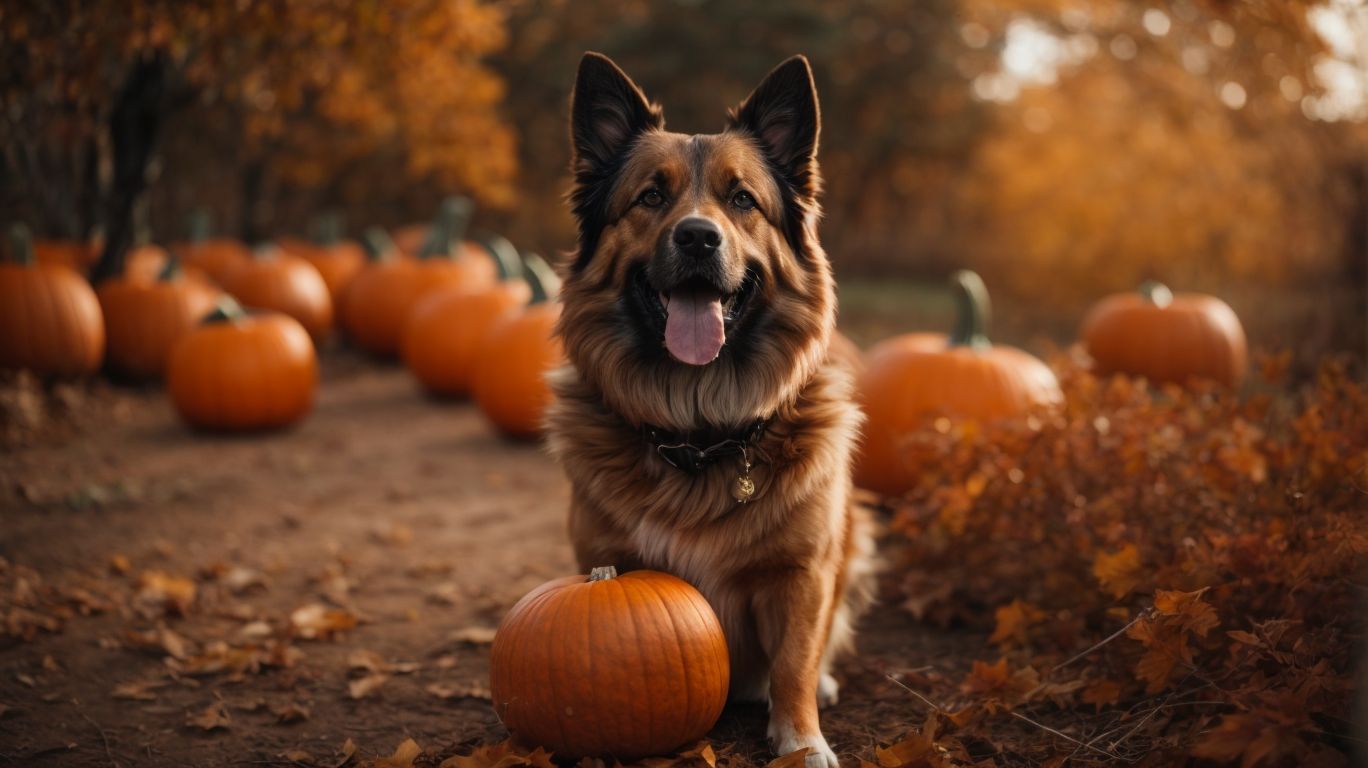
Credits: Poormet.Com – Robert Anderson
Feeding pumpkin to dogs can be a rewarding experience, offering a range of nutrients, health benefits, and culinary versatility that enhance their diet and overall well-being.
Rich in vitamins A, C, and E, as well as fiber, pumpkin serves as a nutritious addition to a dog’s food, supporting their immune system, skin health, and digestion.
The high water content of pumpkin can aid in keeping your furry friend hydrated, especially during warmer seasons. Its low-calorie nature makes it ideal for weight management, and the presence of antioxidants contributes to reducing inflammation, boosting heart health, and protecting against certain diseases.
Frequently Asked Questions
What are the benefits of cooking pumpkin for dogs?
Cooking pumpkin for dogs can provide a variety of health benefits, such as improved digestion, weight management, and a boost in immune system. It is also a good source of fiber, vitamins, and minerals for your furry friend.
Can dogs eat raw pumpkin?
Yes, dogs can eat raw pumpkin in small amounts, but it is recommended to cook it before feeding it to your dog. Cooking pumpkin makes it easier for dogs to digest and also helps release more nutrients.
How can I cook pumpkin for my dog?
There are several ways to cook pumpkin for your dog, such as boiling, baking, or steaming it. Make sure to remove the seeds and skin before cooking, and avoid adding any spices or seasonings.
Is pumpkin safe for dogs with sensitive stomachs?
Yes, pumpkin is safe for dogs with sensitive stomachs. In fact, it is often recommended for dogs with digestive issues, as it is easily digestible and can help soothe an upset stomach.
How often should I feed my dog cooked pumpkin?
The frequency of feeding cooked pumpkin to your dog depends on their size and specific health needs. It is best to consult with your veterinarian for advice on how much and how often to feed your dog pumpkin.
Can puppies eat cooked pumpkin?
Yes, puppies can eat cooked pumpkin in small amounts. However, it is important to introduce new foods slowly and in moderation to avoid any stomach upset. Always consult with your veterinarian before adding cooked pumpkin to your puppy’s diet.

